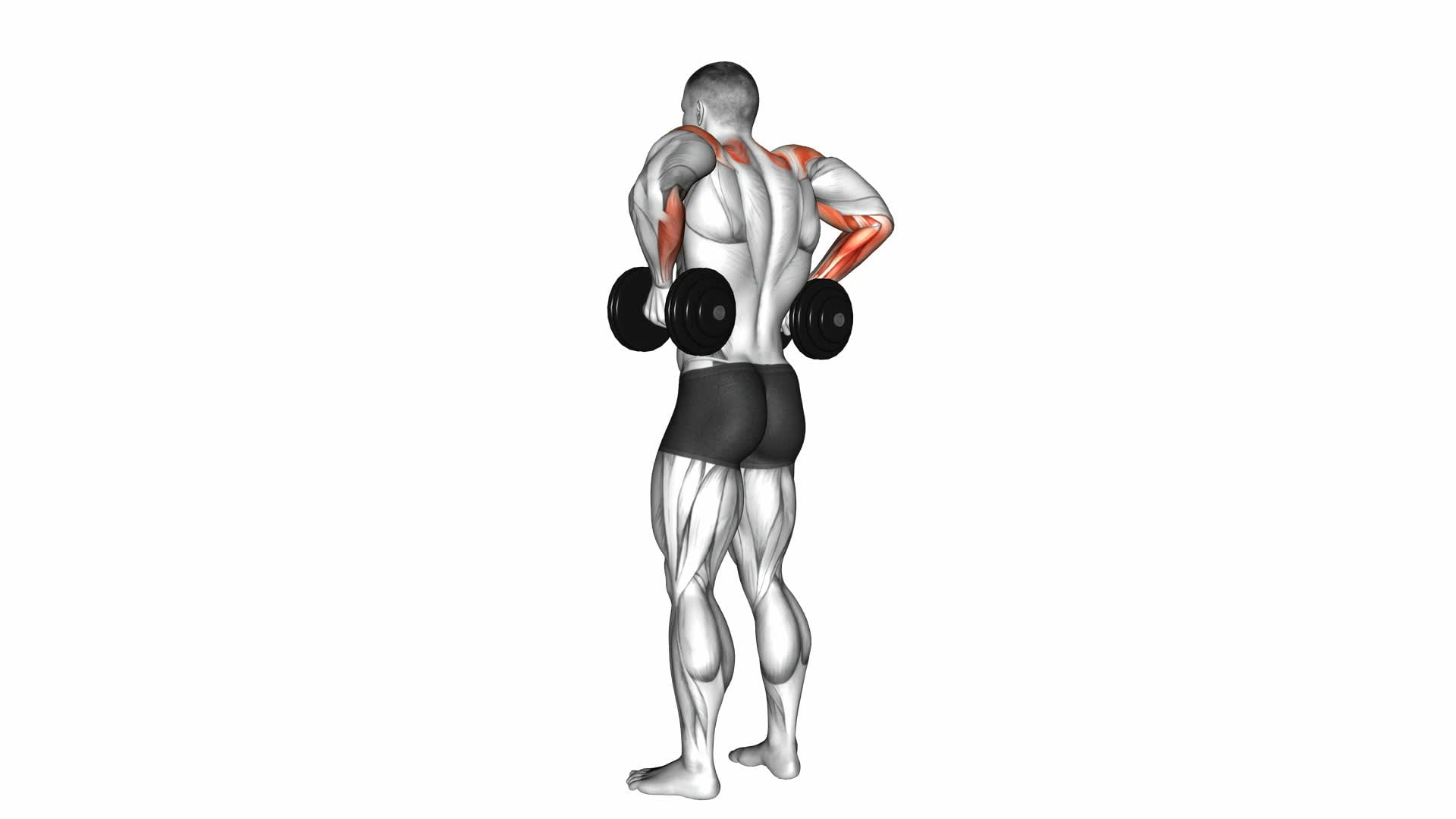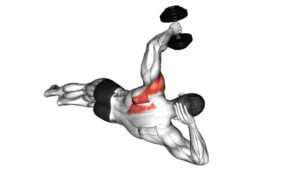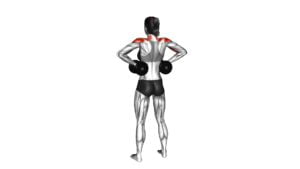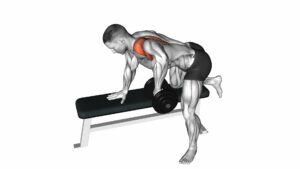Dumbbell Rear Delt Raise – Video Exercise Guide & Tips

Are you looking to strengthen your rear deltoids? The dumbbell rear delt raise is a fantastic exercise that targets this specific muscle group.
Watch This Exercise Video
In this video exercise guide, we will show you the proper form and technique to perform this exercise effectively. You'll also learn about the recommended weight and reps, common mistakes to avoid, and advanced variations for progression.
Get ready to sculpt strong and defined rear delts with this comprehensive guide!
Key Takeaways
- Dumbbell Rear Delt Raise targets the rear deltoid muscles and promotes balanced shoulder development.
- It enhances overall shoulder strength and stability, reducing the risk of injury during upper body exercises.
- The exercise helps correct muscular imbalances in the shoulders and improves posture by strengthening the upper back muscles.
- Incorporating advanced variations and proper form ensures maximum effectiveness and gradual strength building over time.
Benefits of Dumbbell Rear Delt Raise
You can experience significant shoulder muscle development by incorporating dumbbell rear delt raises into your workout routine. This exercise specifically targets the rear deltoid muscles, which are located on the back of your shoulders. By performing rear delt raises with dumbbells, you can effectively activate and strengthen these muscles.
Muscle activation is a key benefit of dumbbell rear delt raises. This exercise isolates the rear deltoids, ensuring that they're the primary muscles being worked. This targeted activation helps to promote balanced shoulder development and can enhance overall shoulder strength.
Additionally, dumbbell rear delt raises can improve shoulder stability. The rear deltoids play an important role in stabilizing the shoulder joint, especially during movements that involve pulling or retracting the shoulder blades. By strengthening these muscles, you can enhance your shoulder stability and reduce the risk of injury during various upper body exercises.
To perform dumbbell rear delt raises, stand with your feet shoulder-width apart and hold a dumbbell in each hand. Bend forward at the hips, keeping your back straight and your core engaged. Raise both arms out to the sides, leading with your elbows, until your upper arms are parallel to the floor. Slowly lower the dumbbells back down and repeat for the desired number of repetitions.
Incorporating dumbbell rear delt raises into your workout routine can provide significant benefits for muscle activation and shoulder stability. By targeting the rear deltoids, you can enhance your shoulder strength and reduce the risk of injury during upper body exercises.
Proper Form and Technique
To ensure proper execution of the dumbbell rear delt raise, it's crucial to maintain correct form and technique throughout the exercise. Proper technique not only maximizes the effectiveness of the exercise but also helps prevent injury.
One common mistake is using too much weight, which can compromise form and lead to muscle imbalances. To avoid this, start with lighter weights and gradually increase as your strength improves.
Another mistake is swinging the weights or using momentum to lift them, rather than relying on the muscles of the rear deltoids. To fix this, focus on controlled movements, lifting the weights up and down in a smooth and controlled manner.
Additionally, it's important to maintain a neutral spine and engage your core throughout the exercise to ensure proper alignment and stability.
Lastly, avoid shrugging your shoulders or hunching your back, as this takes the emphasis away from the rear deltoids.
Recommended Weight and Reps
Maintain proper form and technique by selecting an appropriate weight and determining the number of reps for the dumbbell rear delt raise. The recommended weight range for this exercise is typically between 5 to 15 pounds, depending on your fitness level and strength. It's important to start with a lighter weight and gradually increase as you build strength and proficiency. Remember, the focus of the dumbbell rear delt raise is to target the rear deltoid muscles, so it's crucial to choose a weight that allows for proper muscle activation without compromising form.
When it comes to determining the number of reps, it's generally recommended to perform 8 to 12 repetitions per set. This range promotes muscle growth and strength development, while also allowing for sufficient muscle activation. However, it's essential to listen to your body and adjust the number of reps accordingly. If you're just starting out or have limited shoulder strength, you may want to begin with fewer reps and gradually increase as you progress. On the other hand, if you're more experienced and looking to challenge yourself, you can opt for higher reps or even incorporate drop sets to intensify the workout.
Ultimately, the weight and reps for the dumbbell rear delt raise should be tailored to your individual fitness goals and abilities.
Common Mistakes to Avoid
To maximize the effectiveness of the dumbbell rear delt raise and avoid potential errors, it's crucial to be aware of common mistakes that can hinder your progress. Here are some common mistakes to avoid and tips on proper technique:
- Using too much weight: One of the most common mistakes is using weights that are too heavy. This can lead to improper form and put unnecessary strain on your muscles. Start with lighter weights and gradually increase as you build strength.
- Raising the dumbbells too high: Another mistake is lifting the dumbbells higher than shoulder level. This reduces the engagement of the rear deltoids and shifts the focus to other muscles. Keep the movement controlled and stop when your arms are parallel to the ground.
- Swinging the body: It's important to maintain a stable and controlled movement throughout the exercise. Avoid using momentum or swinging your body to lift the weights. This not only decreases the effectiveness of the exercise but also increases the risk of injury.
Advanced Variations for Progression
Try incorporating advanced variations of the dumbbell rear delt raise to continue challenging your muscles and progress in your fitness journey.
If you want to switch things up, you can try using resistance band alternatives instead of dumbbells. Resistance bands provide a different type of resistance, which can help activate your muscles in a unique way.
To perform the resistance band rear delt raise, secure the band to a stationary object, such as a door handle or a sturdy pole. Stand facing the anchor point and hold the band with an overhand grip. Keeping your arms straight, pull the band towards your sides, squeezing your shoulder blades together at the top of the movement. Control the band as you return to the starting position.
In addition to resistance bands, you can also incorporate other exercises to target your rear delts and further enhance your progress. For example, try bent-over lateral raises, reverse flyes, or face pulls. These exercises work the same muscle group but from different angles, providing a well-rounded workout for your rear delts.
Remember to always use proper form and start with lighter weights or resistance bands before progressing to more challenging variations. Listen to your body and adjust the intensity as needed to avoid injury.
Keep pushing yourself and incorporating advanced variations to continuously challenge your muscles and achieve your fitness goals.
Frequently Asked Questions
Can Dumbbell Rear Delt Raises Help Improve Posture?
Yes, dumbbell rear delt raises can definitely help improve your posture. By targeting the rear delts, these exercises strengthen the muscles in your upper back, which play a crucial role in maintaining proper posture.
In addition to improving posture, dumbbell rear delt raises also contribute to overall upper body strength. To maximize effectiveness, make sure to execute the exercise correctly, focusing on maintaining proper form and using an appropriate weight for your fitness level.
Are There Any Modifications or Alternatives for Individuals With Shoulder Injuries?
If you have a shoulder injury, there are modifications and alternative exercises you can do instead of the dumbbell rear delt raise. It's important to listen to your body and not push through any pain.
Some modifications include:
- Using lighter weights or resistance bands
- Performing the exercise with a neutral grip
Alternative exercises that target the rear delts include:
- Bent-over lateral raises
- Face pulls
- Seated cable rows.
How Often Should Dumbbell Rear Delt Raises Be Performed for Optimal Results?
To achieve optimal results with dumbbell rear delt raises, it's important to consider the frequency and weight.
Focus on performing this exercise 2-3 times a week, allowing your muscles to rest and recover in between sessions.
As for the weight, choose a dumbbell that challenges you but still allows you to maintain proper form throughout the exercise.
Finding the right balance will help you achieve the best results for your rear deltoids.
Can Dumbbell Rear Delt Raises Help Reduce Shoulder Pain and Discomfort?
Dumbbell rear delt raises are effective for improving shoulder strength and can help reduce shoulder pain and discomfort. They specifically target the rear delts, which play a crucial role in stabilizing the shoulder joint.
Compared to other shoulder exercises, such as lateral raises or shoulder presses, rear delt raises isolate and target the rear delts more effectively.
Incorporating dumbbell rear delt raises into your workout routine can be a beneficial addition for overall shoulder health and strength.
Are There Any Specific Warm-Up Exercises That Should Be Done Before Performing Dumbbell Rear Delt Raises?
Before performing dumbbell rear delt raises, it's important to do specific warm-up exercises. These exercises help prepare your shoulders and prevent injury.
Some examples of warm-up exercises include arm circles, shoulder rotations, and band pull-aparts. These exercises increase blood flow, activate the muscles, and improve flexibility.
Conclusion
In conclusion, the dumbbell rear delt raise is an effective exercise for targeting and strengthening the rear deltoid muscles.
By maintaining proper form and technique, using the recommended weight and reps, and avoiding common mistakes, you can maximize the benefits of this exercise.
Additionally, incorporating advanced variations can help you progress and continue challenging your muscles.
So grab some dumbbells and start reaping the benefits of the dumbbell rear delt raise today!

Author
Years ago, the spark of my life’s passion ignited in my mind the moment I stepped into the local gym for the first time. The inaugural bead of perspiration, the initial endeavor, the very first surge of endorphins, and a sense of pride that washed over me post-workout marked the beginning of my deep-seated interest in strength sports, fitness, and sports nutrition. This very curiosity blossomed rapidly into a profound fascination, propelling me to earn a Master’s degree in Physical Education from the Academy of Physical Education in Krakow, followed by a Sports Manager diploma from the Jagiellonian University. My journey of growth led me to gain more specialized qualifications, such as being a certified personal trainer with a focus on sports dietetics, a lifeguard, and an instructor for wellness and corrective gymnastics. Theoretical knowledge paired seamlessly with practical experience, reinforcing my belief that the transformation of individuals under my guidance was also a reflection of my personal growth. This belief holds true even today. Each day, I strive to push the boundaries and explore new realms. These realms gently elevate me to greater heights. The unique combination of passion for my field and the continuous quest for growth fuels my drive to break new ground.







